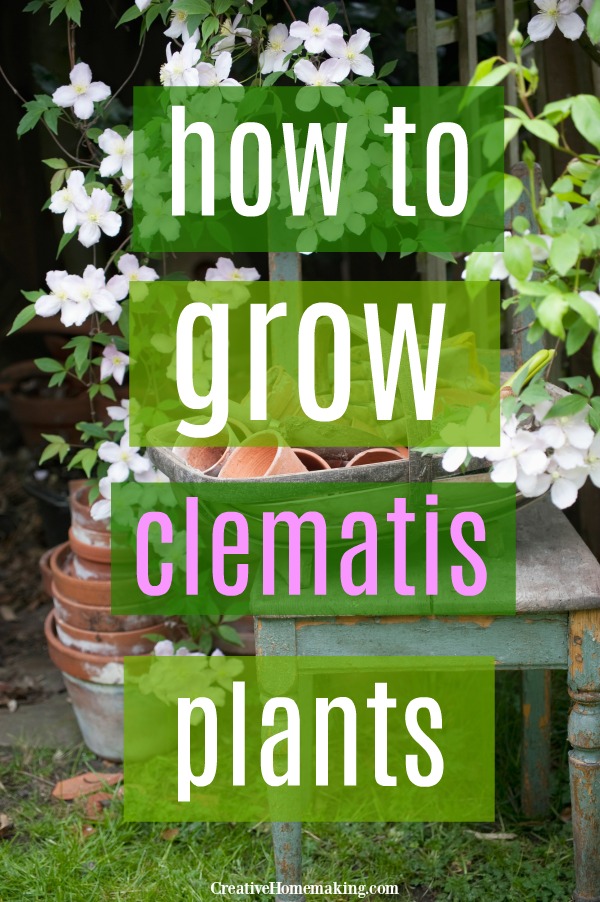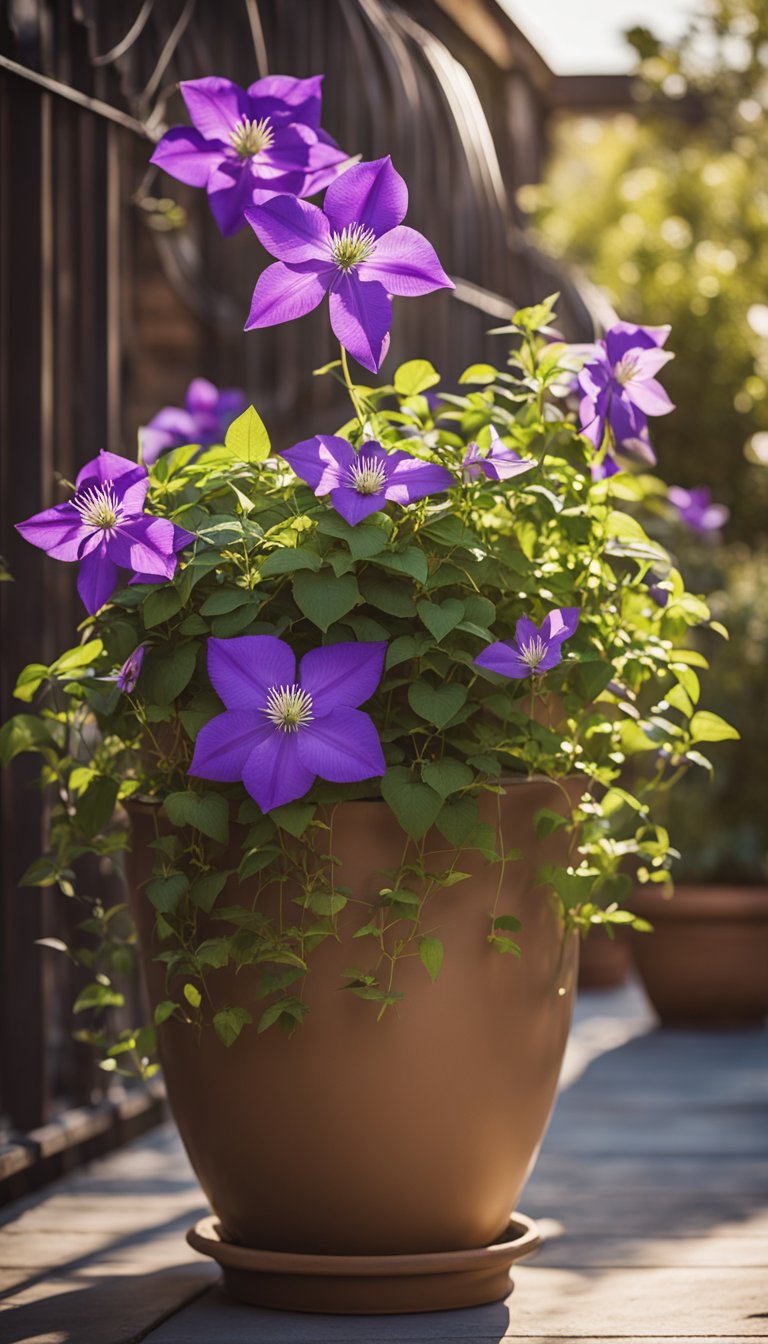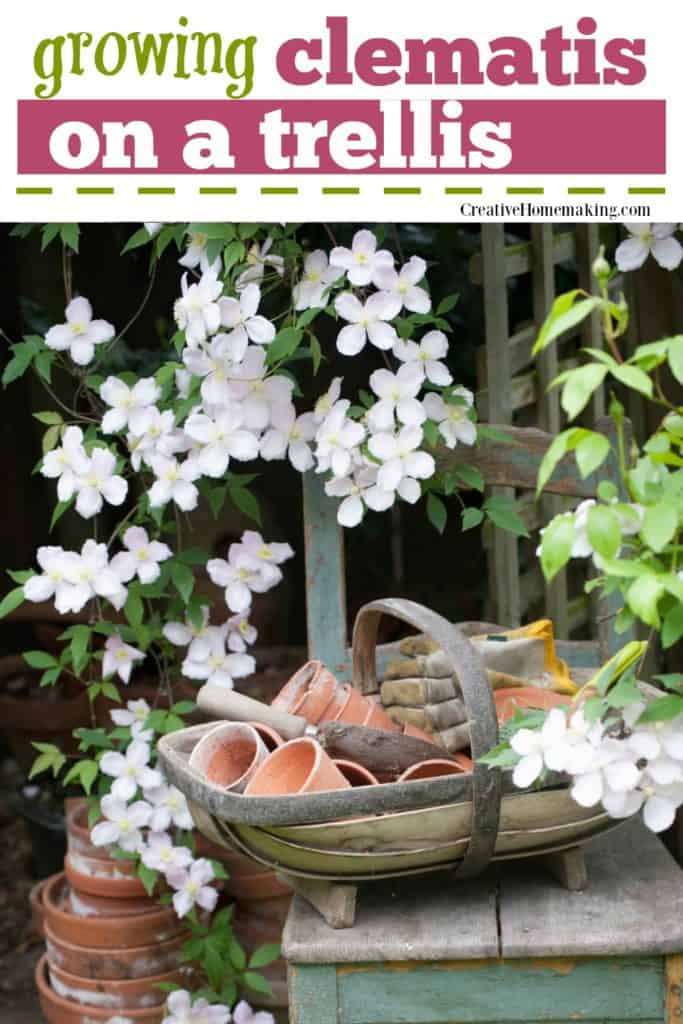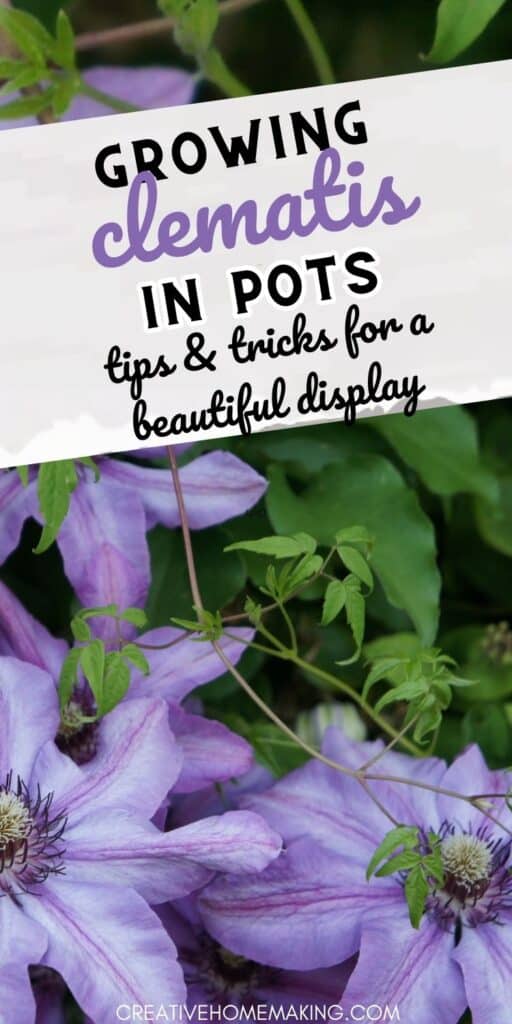Clematis is a beautiful and versatile flowering vine that can add color and interest to any garden or outdoor space. While many people grow clematis on trellises or other supports in the ground, it is also possible to grow clematis in pots.
This post may contain affiliate links.
In fact, growing clematis in pots can be a great option for those with limited space, or for those who want to move their plants around to different areas of their yard or patio.
When it comes to growing clematis in pots, there are a few things to keep in mind. First, it’s important to choose the right container. Clematis vines have deep roots, so you’ll need a pot that is at least 18 inches deep and wide enough to accommodate the plant’s growth.
You’ll also want to make sure the pot has good drainage, as clematis doesn’t like to sit in wet soil. Finally, choose a potting mix that is well-draining and nutrient-rich.
Once you have your container and potting mix, it’s time to choose your clematis variety. There are many different types of clematis, each with its own unique characteristics.
Some are better suited for growing in pots than others, so be sure to do your research before making a selection. With the right container, soil, and variety, growing clematis in pots can be a rewarding and enjoyable experience.
Choosing the Right Container
When it comes to growing clematis in pots, choosing the right container is crucial. The container you choose will not only affect the growth and health of your plant but also its overall appearance. Here are some things to consider when choosing a container:
Container Materials
There are several types of materials to choose from when it comes to containers for your clematis plant. The most common materials are plastic, stone, ceramic, and clay pots. Each material has its pros and cons.
Plastic pots are lightweight, affordable, and come in a variety of colors and sizes. However, they may not be as durable as other materials and can become brittle over time.
Related Article: How to Grow Zinnias in Pots: A Beginner’s Guide
Stone containers, such as those made from granite or marble, are heavy and sturdy. They can add a touch of elegance to your garden but can be expensive and difficult to move around.
Ceramic pots are a popular choice for their aesthetic appeal. They come in a variety of colors and designs, making them a great choice for adding a pop of color to your garden. However, they can be fragile and may crack or break in extreme temperatures.
Clay pots, also known as terracotta pots, are a classic choice for container gardening. They are affordable, porous, and provide good drainage for your plant. However, they can be heavy and may crack in extreme temperatures.
Size and Drainage
When it comes to container size, it’s important to choose a pot that is appropriate for the size of your clematis plant.
A pot that is too small can restrict root growth and limit the overall size of your plant. On the other hand, a pot that is too large can lead to overwatering and waterlogged soil.
In addition to size, proper drainage is essential for the health of your clematis plant. Make sure your container has drainage holes to prevent water from pooling at the bottom of the pot. You can also add a layer of pebbles or stones at the bottom of the pot to improve drainage.

By considering the material, size, and drainage of your container, you can ensure that your clematis plant thrives in its new home.
Selecting and Preparing the Soil
Growing clematis in pots requires careful attention to soil selection and preparation. The right soil composition is crucial for the plant’s growth and development. This section will discuss the two essential factors to consider when selecting and preparing soil for clematis in pots.
Related Article: Growing Blackberries in Pots: Tips and Tricks
Soil Composition
Clematis requires well-draining soil that is rich in organic matter. A suitable soil mix for clematis in pots should contain a blend of potting soil, compost, and organic matter such as coconut coir.
The potting soil provides the necessary nutrients while the compost and organic matter help retain moisture.
Adding perlite to the soil mix can also improve drainage and aeration. Perlite is a lightweight, porous material that helps prevent soil compaction and improves drainage. A good soil mix for clematis in pots should contain 30-50% perlite.
Drainage and Aeration
Good drainage and aeration are essential for clematis in pots. Poor drainage can lead to waterlogging, which can cause root rot and other diseases. To improve drainage, add a layer of gravel or broken pottery to the bottom of the pot before adding the soil mix.
Related Article: How to Grow Blueberries in Pots
Aeration is also crucial for healthy clematis growth. The soil mix should be loose and well-aerated to allow air to circulate around the roots. Adding perlite or vermiculite to the soil mix can improve aeration and prevent soil compaction.

Planting and Supporting Clematis
Planting Techniques
Clematis is a beautiful flowering vine that can be grown in pots with proper care. The first step to growing clematis in pots is choosing the right container.
The container should be at least 18 inches deep and wide enough to accommodate the root system. It is recommended to use a container with drainage holes to prevent waterlogging.
Related Article: Growing Lemon Balm in Pots
Before planting, prepare the soil by mixing equal parts of potting soil and compost. Clematis prefers well-draining soil that is rich in organic matter.
When planting, place the root ball in the center of the container and fill it with the soil mixture. Water the plant thoroughly and add a layer of mulch to retain moisture.
Clematis needs support to grow properly. You can use a trellis or fence to support the vine. It is recommended to install the support structure before planting to avoid damaging the root system later.
Support Structures
Clematis can grow up to 20 feet long, so it is essential to provide adequate support. A trellis is an excellent option for clematis as it allows the vine to climb and spread. It is recommended to choose a sturdy trellis that can withstand the weight of the plant.
Another option is to use a fence as a support structure. You can attach the vine to the fence with ties or clips. It is recommended to choose a fence that is at least 6 feet high to allow the vine to grow to its full potential.

Caring for Clematis in Pots
Growing clematis in pots can be a great way to add color and texture to your patio or balcony. However, caring for clematis in pots requires some attention to detail. In this section, we will discuss some tips for keeping your potted clematis healthy and thriving.
Related Article: Best Soil for Strawberries in Pots
Watering and Moisture
Clematis in pots need regular watering to stay healthy. During hot and dry weather, they may require watering every day. Make sure the pot has good drainage to prevent waterlogging, which can lead to root rot. If the soil feels dry to the touch, it’s time to water.
To help retain moisture, consider adding a layer of mulch to the top of the soil. This will help keep the soil cool and moist, and prevent it from drying out too quickly.
Fertilizing and Mulching
Clematis in pots benefit from regular fertilizing. Use a balanced fertilizer once a month during the growing season to provide the plant with the nutrients it needs to thrive. Be careful not to over-fertilize, as this can lead to excessive growth and weak stems.
Mulching is also important for potted clematis. A layer of mulch will help retain moisture and keep the soil cool. Use a natural mulch, such as shredded bark or compost, and apply it in a layer about 2-3 inches thick.
Related Article: Growing Hydrangeas in Pots
Pruning and Maintenance
Pruning is an essential part of caring for clematis in pots. Regular pruning will help keep the plant healthy and encourage new growth. Prune in late winter or early spring before new growth begins. Cut back the previous year’s growth to about 6-8 inches above the soil level.
To keep your potted clematis looking its best, remove any dead or damaged stems as soon as you notice them. This will help prevent disease and keep the plant looking tidy.

Protecting Clematis Through the Seasons
Clematis is a beautiful flowering plant that can thrive in pots. However, to ensure that your clematis blooms every year, it is important to protect it through the changing seasons.
Seasonal Care
In spring and summer, clematis requires regular watering and fertilizing to encourage healthy growth and blooms. During fall, reduce watering and stop fertilizing to allow the plant to prepare for dormancy.
In winter, clematis goes dormant and requires protection from frost and freezing temperatures. Insulate the pot with bubble wrap or hessian to protect the roots from freezing. It is also important to keep the soil moist but not waterlogged during winter.
Overwintering Clematis
To overwinter clematis successfully, prune the plant in late fall to remove any dead or damaged stems. Cut the remaining stems back to about 12 inches and cover the pot with a layer of mulch to protect the roots.
If the pot is small enough, move it into a sheltered area such as a garage or shed. Alternatively, wrap the pot with insulating material such as fleece or burlap to protect it from the elements.
Frequently Asked Questions
What type of trellis is suitable for supporting clematis in pots?
Clematis plants need support to grow properly, and a trellis is an excellent option for providing this support.
When choosing a trellis for your clematis plant, make sure it is sturdy enough to withstand the weight of the plant and its foliage. A trellis made of wood or metal is a good choice, as it can be anchored securely to the pot and provide the necessary support.
Which varieties of clematis are well-suited for growing in shaded areas in containers?
Clematis plants thrive in full sun, but some varieties can tolerate partial shade. If you plan to grow clematis in a shaded area, choose a variety that is well-suited for this environment.
Some good options include Clematis ‘Comtesse de Bouchaud’, Clematis ‘Nelly Moser’, and Clematis ‘Pink Champagne’.
How do you care for clematis growing in pots indoors?
Clematis plants can be grown indoors in pots, but they require proper care to thrive. Make sure the pot has good drainage and is filled with a high-quality potting mix.
Water the plant regularly, but be careful not to overwater it. Provide the plant with plenty of sunlight, and consider using a grow light if necessary.
What are the ideal conditions for overwintering clematis in containers?
Clematis plants can be overwintered in containers, but they require proper care to survive. The ideal conditions for overwintering clematis include a cool, dark location with temperatures between 35 and 45 degrees Fahrenheit.
Water the plant sparingly during the winter months, and make sure the pot is protected from freezing temperatures.
How frequently should clematis be watered when planted in pots?
Clematis plants require regular watering, especially when planted in pots. Water the plant deeply once or twice a week, depending on the size of the pot and the weather conditions. Make sure the pot has good drainage, and avoid overwatering the plant, as this can lead to root rot.
What size and type of container is recommended for growing clematis?
Clematis plants require a large container to grow properly, as they have a deep root system. A container that is at least 18 inches deep and wide is recommended.
Choose a container made of a durable material, such as ceramic or plastic, that can withstand the weight of the plant and its foliage.
Follow my Gardening board on Pinterest.



